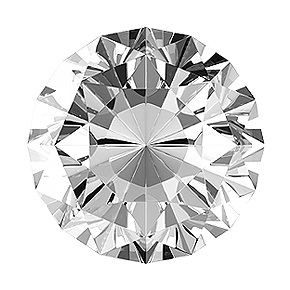
The brilliant round diamond has set the standard for all other diamond shapes, and is loved for its sparkle and versatility. In addition to being the most popular and researched shape, a round diamond will typically give you more flexibility in terms of balancing cut, color, and clarity grades while still getting the fire and brilliance you want.

This even, perfectly symmetrical stone flatters small hands and shorter fingers—the diamond’s shape gives the illusion of lengthening the hand. When it comes to dazzle, the oval cut definitely has it, thanks to its contrasting silhouette which reflects and retracts light, creating a fiery shine.
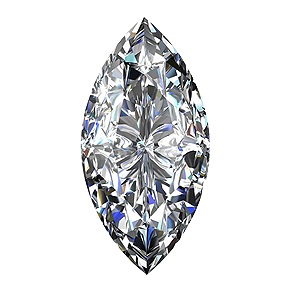
This elongated shape with pointed ends was inspired by the stunning smile of the Marquise de Pompadour and commissioned by France’s Louis XV, who wanted a diamond to mirror his mistress’ grin. Today this diamond is wildly popular - in recent years it was voted the favorite fancy diamond shape.
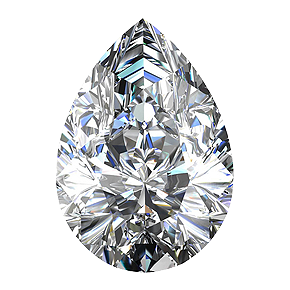
Combining the best of the oval and the marquise cut, its shape is reminiscent of a sparkling teardrop. The unique look of the pear shape helps make it a popular choice for a variety of diamond jewelry. If you choose an elongated pear shape, the length of the diamond creates a subtle slimming effect on the fingers.
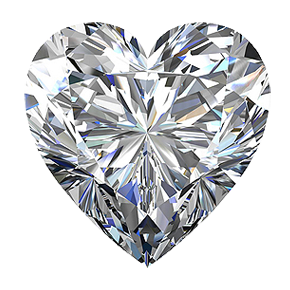
This is perhaps the funkiest shape, embodying sparkle and brilliant beauty. The unique look of the heart-shaped diamond helps make it a distinctive choice for a variety of diamond jewelry.
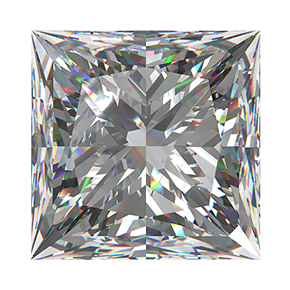
This square or rectangular cut consists of both step and brilliant-cut facets, which produce serious sparkle. Its beautiful brilliance and unique cut makes it a favorite for engagement rings. The princess has pointed corners and is traditionally square in shape.
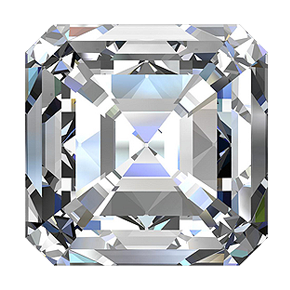
This beautifully unique shape is nearly identical to the emerald-cut, except that it is square. Also, this shape has a pavilion that is cut with rectangular facets in the same style as the emerald-cut.
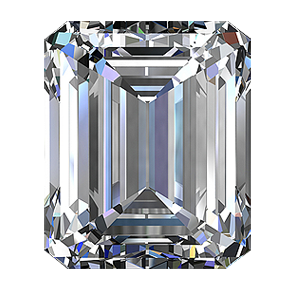
What makes this shape different is its pavilion, which is cut with rectangular facets to create a unique optical appearance. Due to its larger, open table, this shape highlights the clarity of a diamond.
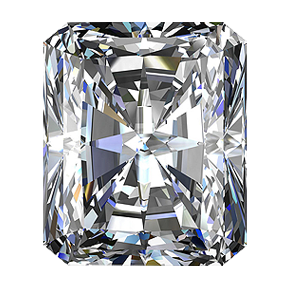
Trimmed corners are the signature of this diamond, and they help make the radiant-cut a popular and versatile choice for jewelry. A radiant-cut looks equally beautiful set with either baguette or round side-diamonds. Radiant-cut diamonds can vary in their degree of rectangularity.
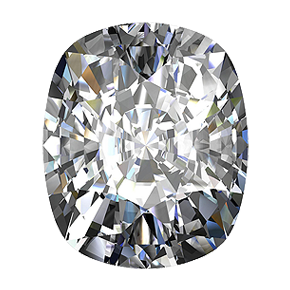
This unique shape has been popular for more than a century. Cushion-cut diamonds (also known as "pillow-cut" diamonds) have rounded corners and larger facets to increase their brilliance. These larger facets highlight the diamond's clarity. Cushion-cut diamonds are available in shapes ranging from square to rectangular.
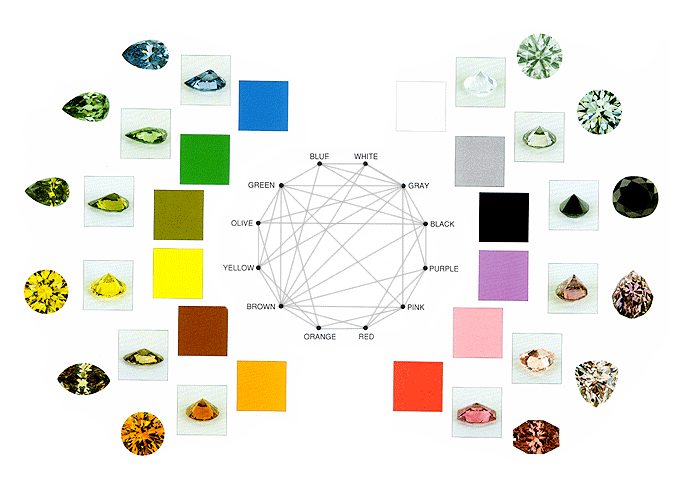
Diamond color is a Fancy Colored Diamond’s most significant characteristic. In fact, unlike a colorless diamond where the 4C's (carat weight, clarity, color, and cut) are all equally important to the overall value, the color characteristic plays the most important role in the value of the diamond. With white diamonds the absence of color is what makes the diamonds so precious. However, in the case of fancy colored diamonds, the presence of color and the intensity of how it shines is specifically what increase the value of the stones.
First off, lets start with the basics. Most of you probably already know that there is a scale of diamond color from D to Z. D, of course, is completely colorless while Z is heavily tinted with yellow. But all along that scale from D to Z, the discussion is still about what are categorized as “white diamonds.” A Z color diamond is a heavily yellow tinted white diamond. The world of diamonds, though, is not limited to this scale. Diamonds falling off this scale are commonly called “Fancy Color Diamonds” or “Fancy Diamonds.” What Diamonds Are Considered “Fancy Color Diamonds”? Diamonds can either fall off this scale because they’re tinted with a shade other than yellow, or because the yellow color inside the diamond is so strong that the diamond is no longer considered a tinted white diamond, but rather a full fledged yellow diamond. Diamonds can come in a variety of colors. The chart below (from Page 12 of “Forever Brilliant: The Aurora Collection of Colored Diamonds”) is an excellent graphical display of the variety of colors in which diamonds can be found.

Hearts and Arrows Diamonds are the most beautiful diamonds in the world. The secret to their beauty is revealed here!
The hearts and arrows pattern (often marketed under brand names such as 'Hearts on Fire') refers to a symmetrical light pattern visible using a specialized viewer in diamonds cut within certain narrow specifications.
Hearts and Arrows Viewer Modern, portable H&A viewers The hearts and arrows pattern was first viewed using a Firescope; a tool developed by Kazumi Okuda in the 1970s. Firescopes and their modern equivalents (such as the H&A Viewer, Ideal-scope and ASET-scope) use colored reflectors to display a pattern showing the direction and intensity of light emitted from a diamond. These colorful patterns can be evaluated to determine how much light is exiting the diamond at proper angles, and whether the diamond is optically symmetrical (indicated by a uniform pattern).
In the example at left, red represents light being emitted from the diamond in a direction and intensity that will be perceived by the viewer as brightness. Pink areas represent areas of less brightness. Dark areas indicate areas where light is blocked by the viewers head (these areas are perceived as dark flashes, or scintillation, when the viewer or the diamond moves). Finally, white areas indicate where light is traveling through the diamond, and 'leaking' out of the bottom (perceived as dull or dark areas in the diamond). Different types of viewers will use different color schemes, but all produce similar patterns.
| Size Range 0.30 up |
| FL, IF, VVS1, VVS2, VS1, VS2, SI1, SI2, SI3, I1, I2, I3 |
| D, E, F, G, H, I, J, K, L, M, N, O-P, Q-R, W-X, Y-Z |
| # | Cut Grades | Description |
|---|---|---|
| 1 | EX | Excellent |
| 2 | VG | Very Good |
| 3 | GD | Good |
| 4 | F | Fair |
| # | Polish | Description |
|---|---|---|
| 1 | EX | Excellent |
| 2 | VG | Very Good |
| 3 | GD | Good |
| 4 | F | Fair |
| # | Symmetry Grades | Description |
|---|---|---|
| 1 | EX | Excellent |
| 2 | VG | Very Good |
| 3 | GD | Good |
| 4 | F | Fair |
| # | Grade | Description |
|---|---|---|
| 1 | N(WT0) | None |
| 2 | NV | None Visible |
| 3 | WT1 | Minor |
| 4 | WT2 | Medium |
| 5 | WT3 | Major |
| # | Grade | Description |
|---|---|---|
| 1 | N(BT0) | None |
| 2 | NV | None Visible |
| 3 | BT1 | Minor |
| 4 | BT2 | Medium |
| 5 | BT3 | Major |
| # | Grade | Inc. Type | Location | Description |
|---|---|---|---|---|
| 1 | N(WC0 /WT0) | Open | --- | None |
| 2 | NV | Open | --- | None Visible |
| 3 | CO1 | Open | Crown | Minor |
| 4 | TO1 | Open | Table | Minor |
| 5 | CO2 | Open | Crown | Medium |
| 6 | TO2 | Open | Table | Medium |
| 7 | CO3 | Open | Crown | Major |
| 8 | TO3 | Open | Crown | Major |
| # | FL Grades | Parameters |
|---|---|---|
| 1 | N | None Fluorescence |
| 2 | FNT | Faint Fluorescence |
| 3 | MED | Medium Fluorescence |
| 4 | STG | Strong Fluorescence |
| 5 | VST | Very Strong Fluorescence |
| # | Grade | Color Shade | Color Shade Description |
|---|---|---|---|
| 1 | N | WH/OF WH/YL | - |
| 2 | NV | Brown/Grey/Pink | None Visible |
| 3 | BRN1 | Brown | Faint |
| 4 | BRN2 | Brown | Light |
| 5 | BRN3 | Brown | Dark |
| # | Grade | Size/Description |
|---|---|---|
| 1 | N(M0) | None |
| 2 | NV | None Visible |
| 3 | M1 | Minor |
| 4 | M2 | Medium |
| 5 | M3 | Major |
| # | Grade | % | Description |
|---|---|---|---|
| 1 | EC1 | 75% - 100% | Sure |
| 2 | EC2 | 50% - 74% | Medium |
| 3 | EC3 | 25% - 49% | Medium |
| 4 | V | 0% - 25% | Inclusion Visible |
| # | Grade | % | Description |
|---|---|---|---|
| 1 | EX | 75% - 100% | Ex H%A |
| 2 | VG | 50% - 74% | VG H%A |
| 3 | NV | 25% - 49% | None Visible |
| 4 | N | 0% - 25% | None |
| # | Grade | Description |
|---|---|---|
| 1 | CM | Canada Mark |
| 2 | CME | Canada Mark Eligible |
| 3 | FM | Forever Mark |
| 4 | FMG | Forever Mark Grading |
| 5 | FME | Forever Mark |
| 6 | FMI | Forever Mark Inscribed |
| # | Lab | Description |
|---|---|---|
| 1 | GIA | Gemological Institute of America |
| 2 | IGI | International Gemological Institute |
| 3 | HRD | Hoge Raad voor Diamant |
| 4 | EGL | European Gemological Laboratory |
| 5 | IIDGR | International Institute of Diamond Grading and Research |
| 6 | AGS | American Gem Society |
| 7 | FAITH | Hari Krishna Export's Certificate |
| 8 | FM | Forever Mark |
| 9 | FMI | Forever Mark Inscribed |
| 10 | FMG | Forever Mark Grading |
| 11 | FMG/I | Forever Mark Grading / Inscribed |
| This is the date on which new goods transfer for sale. |